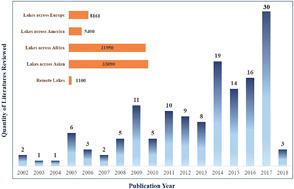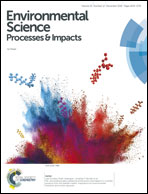Anthropogenic PAHs in lake sediments: a literature review (2002–2018)†
Abstract
Lake sediments are an important reservoir for toxic and hydrophobic polycyclic aromatic hydrocarbons (PAHs). Monitoring of PAHs in sediment is helpful to understand pollution mechanisms and anthropogenic activities. This study reviews studies of PAHs in lake sediments published during 2002–2018. The studies' findings are analyzed, distributions of PAHs in lake sediments are summarized, and the applicability of lake sediments for tracking changes in PAH emission sources is emphasized. Lake sediments heavily polluted with PAHs are distributed in China, Egypt, the USA, and some urban lakes in Africa. The high levels of PAHs are predominantly associated with human activities such as anthropogenic combustion, petroleum industries, road traffic, and socioeconomic factors. However, the concentrations of sedimentary PAHs in most lakes were below the international guideline values.



 Please wait while we load your content...
Please wait while we load your content...